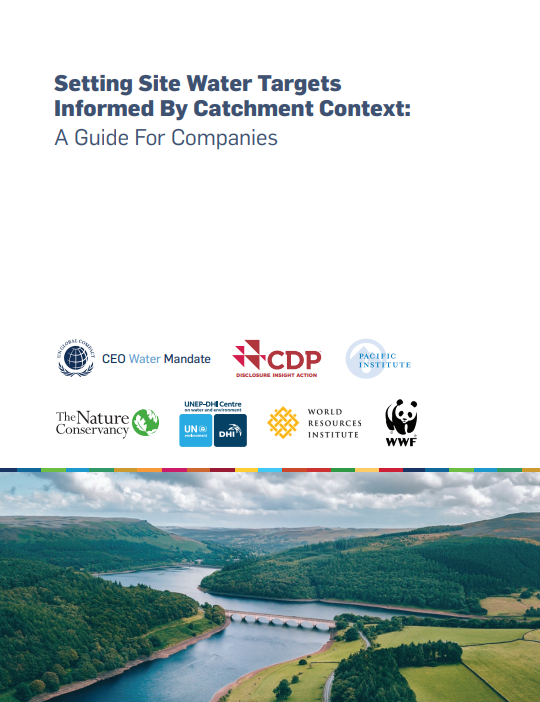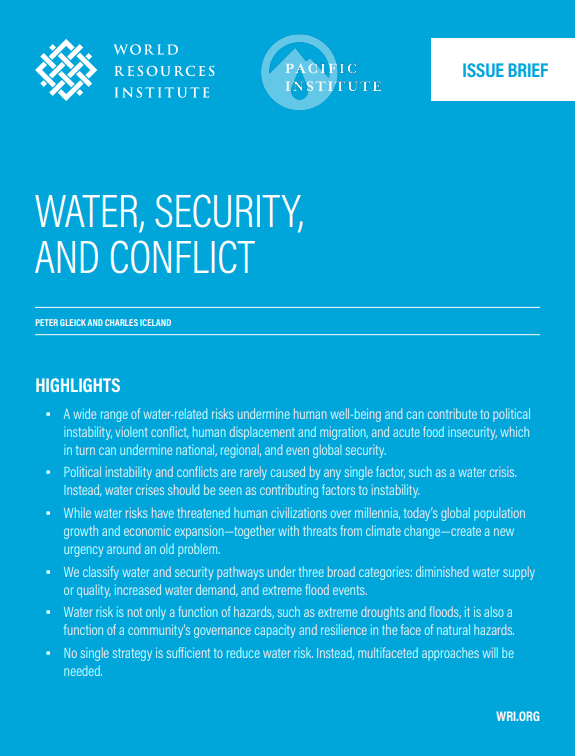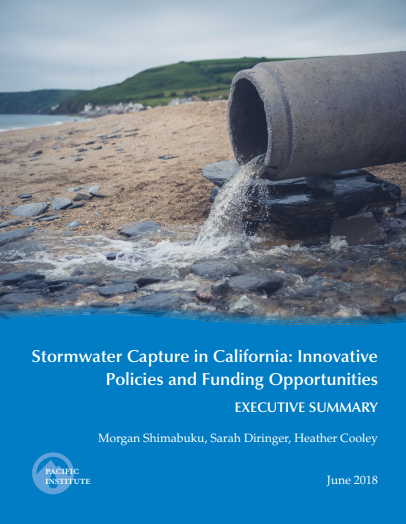1057 Resources
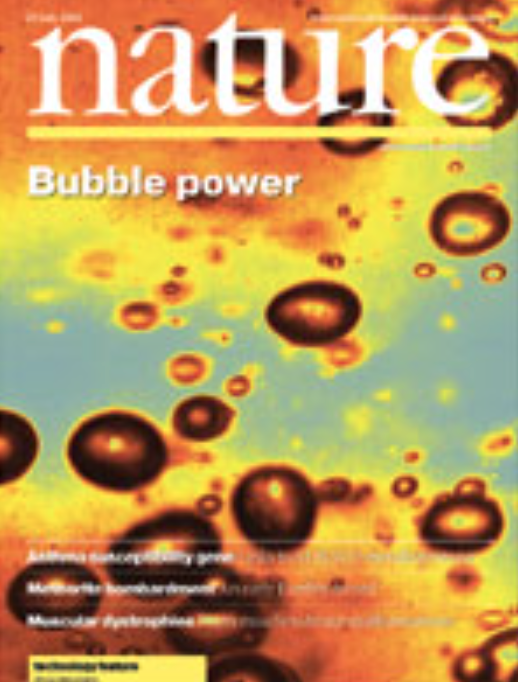
Water Management: Soft Water Paths
July 25, 2002 | publication
The soft path seeks to improve the overall productivity of water use and deliver water services matched to the needs of end users, rather than seeking sources of new supply.
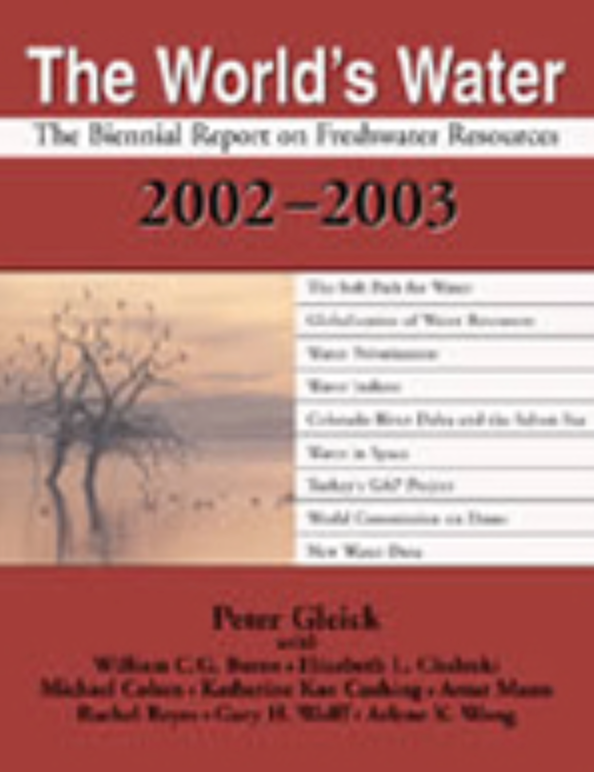
The World’s Water, Volume 3
June 28, 2002 | publication
The third volume in the The World’s Water book series, The World’s Water: 2002-2003 explores and proposes solutions to a variety of critical water issues including the global water crisis, global warming and water, the privatization and globalization of water, and and water-related conflicts.
Fire and Water: An Examination of the Technologies, Institutions, and Social Issues in Arms Control and Transboundary Water-Resources Agreements
June 20, 2002 | publication
This report explores how technologies developed to control the spread of weapons can be used to improve agreements over shared natural resources.

The New Economy of Water: The Risks and Benefits of Globalization and Privatization of Fresh Water
February 26, 2002 | publication
In an increasingly globalized economy, the privatization of water as an economic good has sparked complex debate.
Neighborhood Knowledge for Change: The West Oakland Environmental Indicators Project
January 23, 2002 | publication
The Environmental Indicators Project is the culmination of two years of research, analysis, and collaboration between the grassroots advocacy group
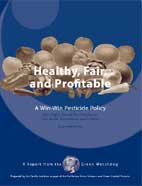
Healthy, Fair, and Profitable: A Win-Win Pesticide Policy
January 12, 2002 | publication
This report released by the Pacific Institute and the California Green Scissors project makes the case for changing the way pesticides are regulated in California.
Creating a Framework for Sustainability in California: Lessons Learned from the New Zealand Experience
December 12, 2001 | publication
New Zealand’s attempt to integrate environmental protection and resource management with a “goals-based” policy framework can help serve as a guide for California as it continues to grapple with resource scarcity.
Op-Ed: Don’t Drill the Arctic: Renewable Energy is Safer, Cleaner, More Secure
December 2, 2001 | publication
The terror attacks of September 11 have brought the vulnerabilities of modern America into stunning relief. Our airports, airplanes and office buildings were far more open to attack then most imagined. And, according to many policy makers and scientists, so is our oil-based economy.
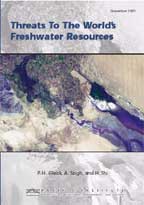
Threats to the World’s Freshwater Resources
November 10, 2001 | publication
As we move into the 21st century, water managers and policymakers must face new threats to the world's freshwater resources.
Defining Transparency: Expectations and Obstacles
October 24, 2001 | publication
The proceedings of a recent workshop jointly hosted by the Pacific Institute and the Global Environmental Management Initiative (GEMI) are now available.
Op-Ed: A Proposal to Preserve and Enhance Habitat at the Salton Sea
October 4, 2001 | publication
Recent discussions and legislative efforts at the state and federal level have again focused attention on the Salton Sea. These recent discussions, on the potential impacts on the Salton Sea of a proposed water transfer from Imperial Valley to the San Diego area, have highlighted the challenges faced by those working to address the current and future problems of the Sea, and the inadequacy of any temporary or piecemeal approach.
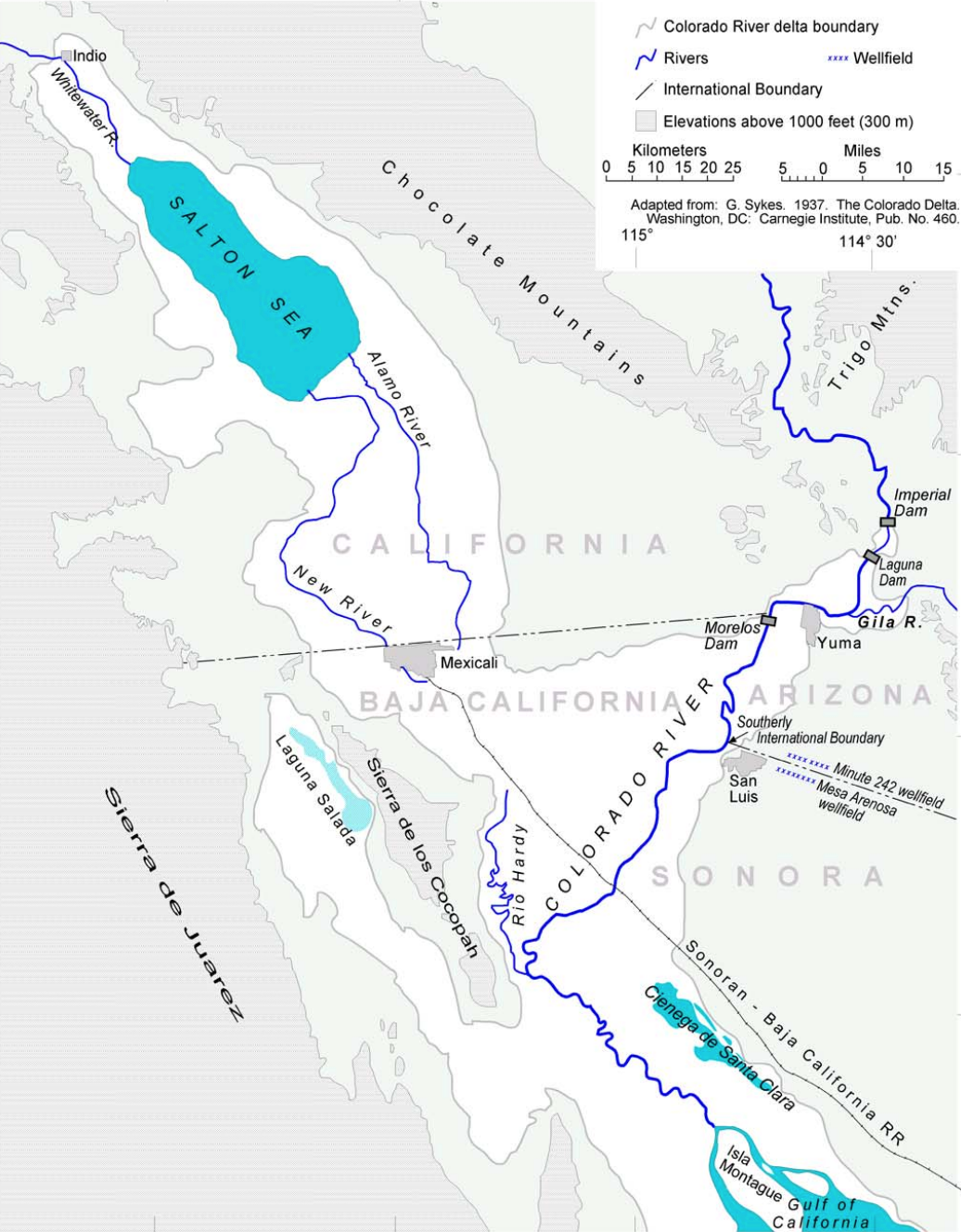
Missing Water: The Uses and Flows of Water in the Colorado River Delta Region
September 26, 2001 | publication
This report represents the first time comprehensive flow data was compiled for the entire Colorado River Delta region.
A New Vigilance: Identifying and Reducing the Risks of Environmental Terrorism
September 26, 2001 | publication
As the global population increases, the world’s existing resources -- water, energy, soil, and more -- are being consumed at an increasing rate.
The National Assessment of the Impacts of Climate Variability and Change
September 26, 2000 | publication
The National Assessment of the Impacts of Climate Variability and Change was a groundbreaking attempt to evaluate the impacts of climate change on the United States.
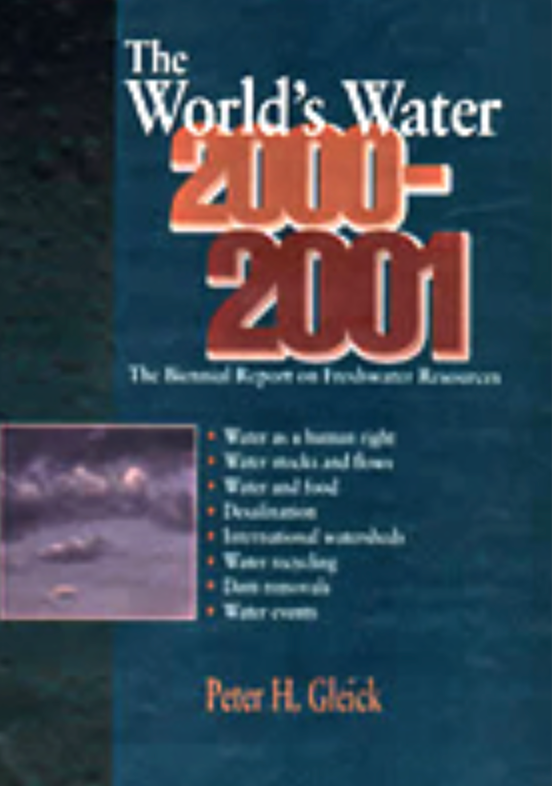
The World’s Water, Volume 2
June 1, 2000 | publication
The second volume of The World’s Water contains new chapters on global water use projections, international river basins, the complex connections between water and food production, desalination, wastewater treatment and reuse, and the legal issues around a human right to water.
Brownfields Redevelopment: Meeting the Challenges of Community Participation
May 26, 2000 | publication
Brownfields are the abandoned or idled commercial and industrial properties that dot our urban and rural landscapes. They often remain unused because of real or perceived contamination, liability risks, and the costs of cleanup.

Comments on the Salton Sea Restoration Project
May 15, 2000 | publication
This document contains comments submitted by the Pacific Institute on the Salton Sea Restoration Project and on the January 2000 draft Environmental Impact Statement/Environmental Impact Report (DEIS) and supporting documents.
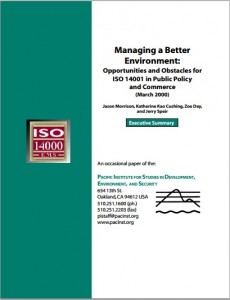
Managing a Better Environment: Opportunities and Obstacles for ISO 14001 in Public Policy and Commerce
March 1, 2000 | publication
Environmental policy is in transition. Many observers believe that the existing regulatory system, though it has accomplished great improvements in environmental quality, is approaching the limits of its effectiveness.

Colorado River Surplus Criteria Proposal
February 15, 2000 | publication
At its upper reaches, the Delta is dominated by vegetation such as cottonwoods and willows, offering more than twice the amount of native riparian habitat found in the entire reach of the river in the United States from Hoover Dam to Morelos Dam.
ISO Proceedings
July 29, 1999 | publication
On July 29, 1999, the Pacific Institute for Studies in Development, Environment and Security hosted a half-day workshop entitled Security ISO 14001 Environmental Management Systems and Public Policy.
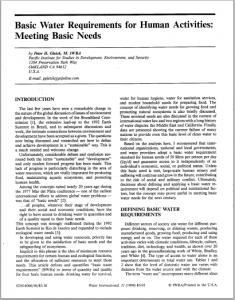
Basic Water Requirements for Human Activities: Meeting Basic Needs
July 9, 1999 | publication
An understanding of basic human water needs is key to ensuring fair and sustainable water supply.
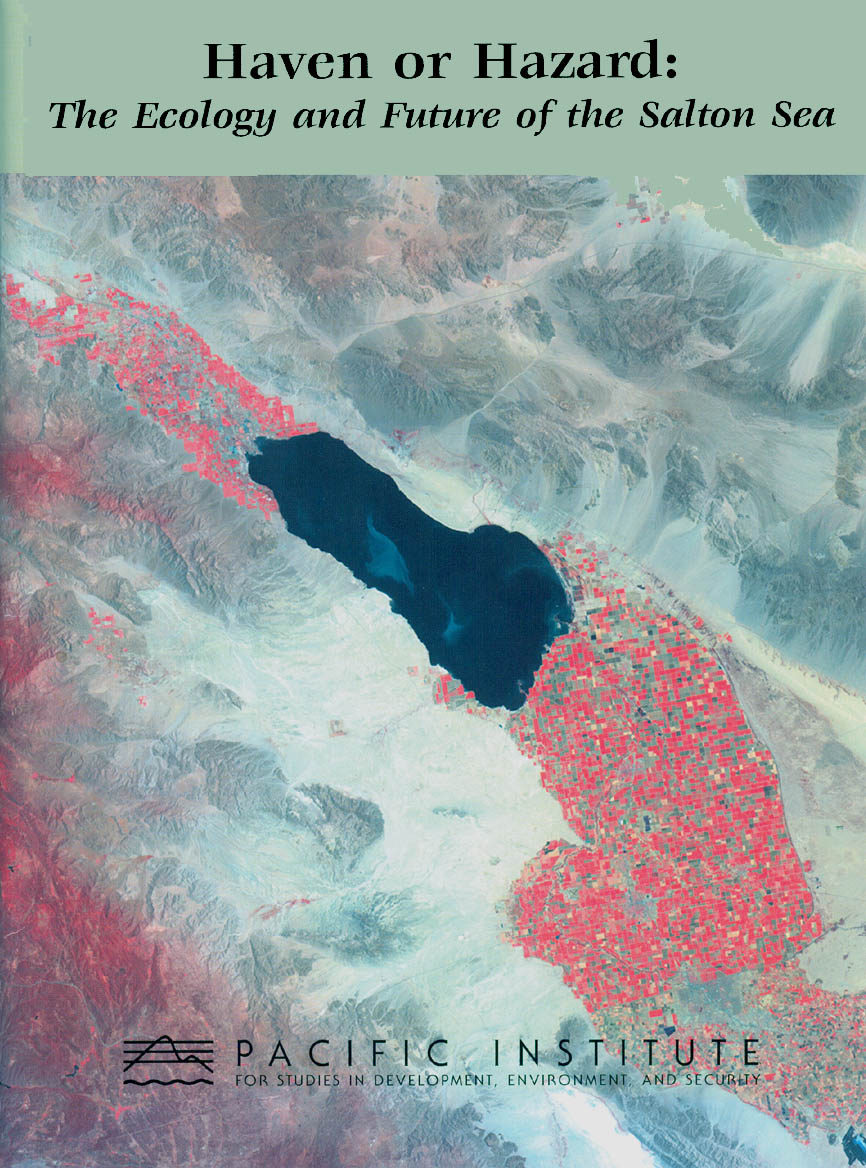
Haven or Hazard: The Ecology and Future of the Salton Sea
February 26, 1999 | publication
California's Salton Sea is a fertile oasis in the hostile desert of south-eastern California. It has been adopted by millions of birds migrating along the Pacific Flyway and also attracts human anglers and boaters
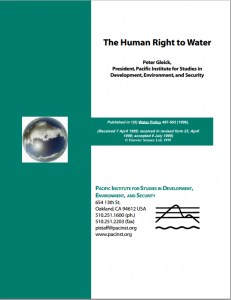
The Human Right to Water
January 13, 1999 | publication
More than a billion people in the developing world lack safe drinking water – an amenity those in the developed world take for granted.
Sustainable Use of Water: California Water Success Stories
January 11, 1999 | publication
The intense political and legal battles that have characterized California water policy throughout the 20th century have not ended—nor are they likely to end in the near future. But unexpectedly, with little fanfare or attention, California is moving toward more sustainable water management and use.
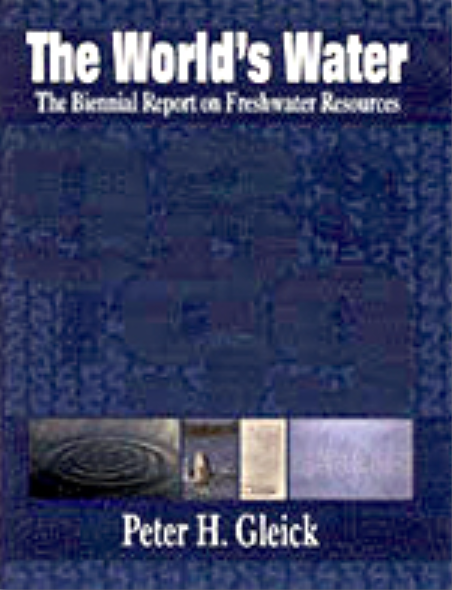
The World’s Water, Volume 1
September 1, 1998 | publication
The first volume of The World’s Water (1998-1999) includes chapters on the changing global paradigm for water management and use, the environmental implications of large dams, possible consequences of climate change, and the links between water resources and conflict.
Page 42 of 43



